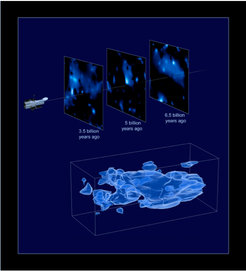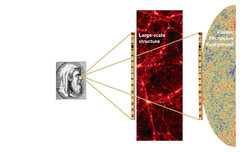Project Description
The most important questions of modern cosmology can be simplified as follows: What are the initial conditions of the universe? What is the nature of gravity? How arises the cosmic acceleration and what is the origin of dark energy and dark matter?
Euclid is predestined to address these questions in great detail by exact analysis of the observed signatures in geometry and within the cosmic structure. Euclid is going to map a large scale area of structure formation over the time span of 10 billion years, i.e. more than 75% of the age of the universe. The mission is optimized for two independent primary cosmological investigations:
(1.) weak gravitational lensing (WL):

The basic idea of weak lensing is the distortion of the path of light from a given background source to the observer in the presence of mass along the way (see also Fig. 1). The image of the background object becomes magnified and stretched towards the foreground mass, which is described by the so-called convergence and shear terms, respectively. Assuming that galaxies have no preferred orientation in space, the statistical estimate of the alignment of the background objects is due to lensing by the foreground object and allows to measure its mass. By using background galaxies of different redshift - thus distance - we are able to move the background wallpaper gradually out in space and map the mass distribution in space along the distance axis. Instrumental and atmospheric effects however, cause a smearing of the observed images. Inevitably, the corresponding point spread function (PSF) must be corrected for accordingly. For example, the spatial variability of the PSF ellipticity over a field of view (FoV) of 50 arcmin2 has to be below 10-4.
(2.) baryonic acoustic oscillations (BAOs):

BAOs can be understood as an invariant length scale imprinted at the early phases of the universe and still notable in the irradiating matter recorded today (see Fig. 2). At such early times, the universe was filled by a hot plasma, where photons and baryons (i.e. protons and neutrons) were still coupled. The underlying density fluctuations resulted in overdense regions, where matter gravitationally clustered thereby increasing the pressure counteracting this gravitational pull. This resulted in oscillations within the plasma in a similar way like sound waves originate from pressure differences in the air. The corresponding sound horizon is an certain length scale and can be used to study cosmology. For example, in the cosmic microwave background maps that represent the era of the decoupling of matter and radiation this typical length scale is imprinted in the radiation background. Looking at the large scale matter distribution in the universe at different epochs (redshifts) one can trace the evolution of this typical length scale through time and space. The requirements driven by the BAOs science case are for example survey depth and the spectroscopic accuracy in determining galaxy redshifts.

